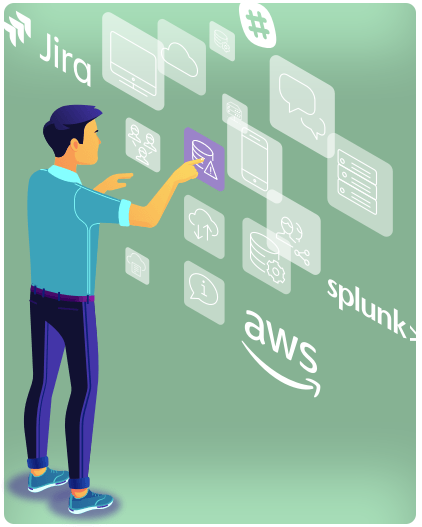Digital Transformation: Cloud Migration Strategy Checklist

Companies moving their applications and services to the cloud is nothing new, but doing business there requires a solid cloud migration strategy. The list of things to consider is longer than you might think. Fortunately, xMatters has done it successfully and has helped its own customers move to the cloud too. In this article, Product Marketing Manager Erin Jones gives a checklist you can use to get your cloud migration right.
In the not-so-distant future, we could have people living on Mars. This is not something one decides overnight. Rather, it’s taken decades already to do the research and planning necessary to even begin to put a date to this concept. In digital business, organizations are undertaking their own monumental journeys as they move to the cloud – and continue to build and scale services there.
Cloud has become standard practice for teams that want to stay competitive and innovative, with 84% of enterprises already leveraging a multi-cloud strategy. Gartner predicts on-prem services (as a percentage of all services) will drop from 80% in 2019 to a mere 40% by 2025.
Brace for the great cloud migration
While many companies have already achieved some level of cloud migration, fewer are moving services and applications to the cloud on a recurring basis. This is important because the benefits of running in the cloud outweigh the security of keeping things on-prem.
According to MarketWatch, “The major reasons for migrating to the cloud are scalability, increased effectiveness, faster implementation, mobility, and disaster recovery, among others. Major companies are offering cloud disaster recovery features to their customers, aiding them to expand their businesses.”
You can’t dive into any forward-thinking technology without invoking the need for cloud — and thus, migration of infrastructure and services to it. Whether you’re just now making the move or are continuing to evolve your cloud infrastructure, there are new opportunities — and new risks — every time you do it.
Moving to the cloud — and determining the most successful path to get there — can be daunting and even risky. You wouldn’t go into outer space without a plan, and you shouldn’t move to the cloud without a cloud migration strategy.
Having helped our own customers make (and continue to make) the shift to cloud (and having done it ourselves), we have some helpful tips to share (so you don’t overlook anything). As a leading incident management platform, we’ve been the cloud safety net for cloud businesses that can’t afford even the slightest service degradation during (or after) their move. Because sometimes, no matter how thoroughly you test and plan, things can go awry — and you’ll want to act quickly (and better yet, preventatively) to ensure your cloud innovation doesn’t equal customer downtime. Leveraging industry best practices for cloud migration — including Gartner’s famous 5 R’s – we’ve put together a comprehensive checklist to help in your migration, whether it’s your first time or your 20th time!
Your Cloud Migration Checklist
Security: Make sure a cloud security tool (or set of tools) is built into your cloud migration strategy. Ensure a security layer at any point where sensitive data (like customer information) will be received or stored. Often, there are multiple services within a cloud infrastructure where this will take place – so be sure you’re securing both the cloud application itself, as well as any gateways where this information is being shared between environments. For mission-critical information deemed too sensitive for the cloud, you may opt to keep this (and its related services) on-prem for extra security. Beyond implementing best-of-breed security practices, it’s important to have a plan for how to take quick action if a breach occurs.
![]()
By integrating xMatters with your security monitoring tools, you can notify teams at the first sign of suspicious behavior and automate processes across the impacted infrastructure to prevent cyber criminals from making off with your sensitive data.
Infrastructure: Companies move to the cloud to scale up and scale down resources more efficiently, but this is not done automatically. Map out what you plan to move to the cloud – and ensure you have the resources to run these things in both high and low volume. While making sure you have the room to run is critical in your initial migration, also consider how you’ll scale these services once you’re in the cloud and growing. Commonly, teams employ tools like elastic load balancers to seamlessly auto-scale services based on volume, so you’ll always have the exact right amount of services to accommodate the load from your end users. If you’re migrating an already complex or enterprise-level infrastructure to the cloud, take additional measures like multiple cloned environments for redundancy in the event of a failover or blue/green rollback strategy. Lastly, for large enterprises with a global market, you’ll want to make sure your cloud services are situated to best serve your respective regions and ensure high availability for end users.
![]()
Because of the innate complexities that come with cloud infrastructure (let alone hybrid cloud), xMatters is integral to help connect all the moving pieces for both total visibility and immediate actionability across environments. Fail to scale in one environment? At the push of a button, xMatters can help redirect the load to another to prevent any degradation of service to customers.
Availability: Migrating to the cloud while continuing to make services available to end users that can’t have downtime is tantamount to building your spaceship as you’re flying it. Before making the move to the cloud, team leaders should present a detailed timeline of what gets moved, when, how long it will take to migrate, and where end users will access services before switching over to the cloud version. Include contingency plans so if any component of the migration fails, teams can quickly revert to the previous functioning version. This will allow end users to work uninterrupted until the migration can be successfully executed. This is the biggest reason migrations are done in a piecemeal, iterative approach rather than in one big, atomic cutover.
![]()
As you’re undertaking the migration of an always-on service (or components thereof), you’ll want xMatters to be your “safety net” between on-prem and cloud, to provide real-time alerts should anything become risky. If xMatters hears from your monitoring tools that a service being migrated begins to perform abnormally, the right on-call resources can be alerted and revert to the fully-functioning on-prem version.
Integrations: Whatever tools and systems you’re bringing to the cloud must be able to communicate with each other (or share information when needed) – or communicate with your remaining on-prem systems. Before making the move to the cloud, teams must consider how applications will remain integrated once they’re in disparate environments – whether that’s cloud to on-prem, or even one cloud to another. Any breakdown in communications between environments can have a detrimental ripple effect, so be sure you have a way to detect (and act on) any interruptions in integration communication.
![]()
By leveraging xMatters to power preventative workflows for fixing broken integrations, you have yet another safety net to keep systems from sending signals into the void.
Testing: You’d be hard-pressed to get even the most enthusiastic of early adopters to commit to being on v1 of our society’s migration to Mars (it’s rumored to be a one-way ticket). Before setting foot on a spaceship for this auspicious new venture, you would want to know that everything from the spaceship to the planned community and its supporting technologies had been thoroughly tested – ideally, in an environment that most closely replicates the conditions of what one would experience in space – to catch any “bugs” before making the trip. Similarly, teams wouldn’t think of shipping their services to the cloud if they hadn’t first performed extensive tests in cloned environments – and perhaps killed some canaries along the way.
xMatters integrates across your testing stack so resources can take real-time action on any failed tests. By quickly identifying the root cause and digging into the fix before customers feel the impact, they can fix the issue before systems or units that don’t pass testing delay your migration (or, worse yet, get released into production).
All systems are go
The day finally arrives when it’s time to press the button, pull the trigger, flip the switch – choose your metaphor. The only question left is: Are you ready?
- The plan: Remember that project plan? Make sure it includes the game day plan for go-live.
- The action: Who is watching what? Do you have an action plan in place for anything that may come up?
- The results: How are you tracking what happens so you can review in post-mortem? How will you evaluate the process to better prepare for putting other services into the cloud?
Prevent > React
The mantra for your journey to the cloud should be Prevent > React (partially because preventing is better than reacting, and partially because of our company’s love for mathematical symbols – just look at our logo!). Plan for every scenario. Be fully prepared. Have your systems ready and your people with specific jobs and roles to play. This is a model for how you’ll run things moving forward in your new cloud world.
While this may seem daunting (only slightly less so than putting society on Mars), the good news is that xMatters can provide a safety net by which to embark on this risky endeavor with a built-in failsafe way to quickly catch and fix anything that goes awry. We’re invested in getting you successfully to the cloud and look forward to serving as a metaphorical co-pilot for many more cloud journeys to come.
Need a cloud migration safety net? Make xMatters your co-pilot… for Free.






